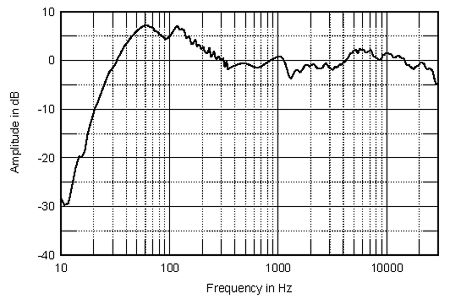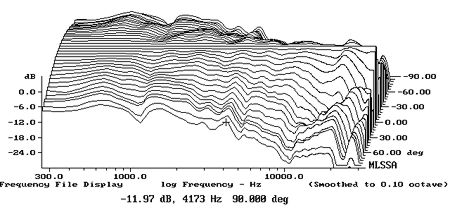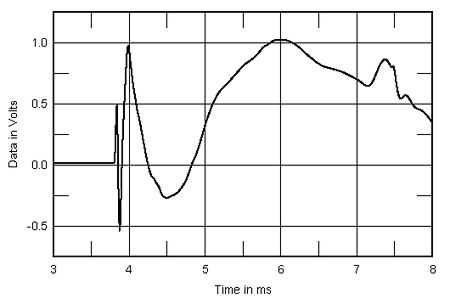| Columns Retired Columns & Blogs |
Sonus Faber Stradivari Homage loudspeaker Measurements
Sidebar 2: Measurements
The drop-dead gorgeous Stradivari Homage is specified as having a very high 92dB voltage sensitivity; to Sonus Faber's credit, my estimated figure was even higher, at 93dB(B)/2.83V/m. However, the speaker asks the partnering amplifier for a lot of current capability, its impedance (fig.1) dropping to 3 ohms and below for much of the upper bass and midrange. And the combination of 4.4 ohms impedance magnitude and –48 capacitive phase angle at 55Hz will give lesser amplifiers conniptions.

Fig.1 Sonus Faber Stradivari Homage, electrical impedance (solid) and phase (dashed) with port open (2 ohms/vertical div.).
Some small discontinuities are apparent in the fig.1 traces, but unfortunately an equipment failure meant I could not investigate the cabinet's vibrational behavior before the speaker had to be returned. However, I did listen to the surfaces with a stethoscope while I played the half-step–spaced chromatic toneburst track on Stereophile's Editor's Choice CD (Stereophile STPH016-2). Fairly strong resonant modes could be heard both between 125Hz and 150Hz and an octave higher than that region. I would have thought that these would add a degree of congestion to the sounds of instruments with high spectral content in the lower midrange—the cello, for example—but Michael Fremer actually thought the Stradivari excelled on this instrument. It's possible that, while these resonances exist, they don't couple to the air very effectively; the Sonus Faber's high sensitivity will also help in this regard.
Franco Serblin's designs for Sonus Faber have always featured complex behavior in the lower region of the audioband, and the Stradivari is no exception. The big port at the base of the rear loads the woofers and is tuned to a low 23Hz, according to fig.1. The small, higher port on the rear of the cabinet loads the midrange unit, but its tuning frequency is not readily apparent from this graph. The nearfield responses of the midrange unit, both woofers, and the lower port are shown in fig.2, plotted up to 1kHz. (The upper port did not seem to do much of anything, at least regarding radiated output.) The black trace in this graph shows the midrange unit's response. It rolls off steadily below 600Hz with a second-order slope. A small inflection in the trace at 100Hz implies that this is the tuning frequency of the upper port. The two woofers behave in an almost identical manner below 300Hz, but the upper woofer (blue trace) has a notch in its output at 500Hz with then a return; the lower woofer rolls off smoothly above the crossover frequency.

Fig.2 Sonus Faber Stradivari Homage, nearfield responses of midrange unit (black), upper woofer (green), lower woofer (blue), and port (red), scaled in the ratio of the radiating diameters.
The crossover frequency between the midrange unit and woofers is specified as lying at 300Hz, but fig.2 indicates that this is not strictly correct. The outputs of all four radiators are plotted in this graph according to the ratio of their diameters, which means that the combined output of the woofers will be 6dB higher than either alone. This in turn moves the graphed crossover point closer to 450Hz and implies that the frequency region covered by the woofers is a little boosted in absolute terms.
The lower port (red trace) covers a broad, two-octave bandpass from 15Hz to 60Hz, and other than a small peak just above 100Hz, its output is well out of the way in the midrange. The black trace to the left of fig.3 shows how these individual drive-unit outputs sum on a nominal farfield point, taking the radiating diameters, acoustic phase, and different distances to that point into account. The rise in the upper bass and midbass will be due in part to the nearfield measurement technique. But as suggested above, it also results from the use of two woofers increasing the speaker's overall output in this region, something that I confirmed by looking at the farfield power response (not shown). But as I said in my Ultimate Ears headphone review last month, a little bit of bass equalization can be very appealing, especially if it is not coupled with any overhang in the time domain. Certainly MF found the Sonus Faber's balance "rich and lush," which is what I would expect from this measured performance in his mid-sized room. In very large rooms, the Stradivari may well sound neutrally balanced in the bass.
Higher in frequency, there is a suspicious-looking step at 1kHz in the on-axis response, which, all things being equal, might add a slight nasality to the Strad's perceived balance. However, Mikey didn't comment on any coloration, nor did I hear any when I auditioned in mono the single speaker I had driven over to my test lab for measurement. (Listening in mono is by far the best way to detect colorations.) According to the specification, the tweeter comes in at a higher-than-usual 4kHz, which makes it look from fig.3 that the unit is balanced a couple of dB too hot. This may well correlate with Mikey's comment that the speaker had a bit of HF "sparkle." Note also that the unit is still giving out almost full output at the 30kHz limit of this graph. This is the first speaker I have measured using a version of the Audio Technology tweeter that didn't start rolling off above the audioband.
The measurements that were made to produce the plot shown in fig.3 were made with the vertical-strings grille off, which is how Mikey auditioned the Strads. Adding the grille gave the response changes shown in fig.4. Reflections from the grille resulted in some comb-filtering, as well as rolloffs of about 1dB at 20kHz and 3dB at 30kHz. But these effects are considerably less severe than those of the ostensibly similar grille Krell uses for its LAT and Resolution speakers (see November 2004, p.108, fig.5).

Fig.3 Sonus Faber Stradivari Homage, anechoic response on tweeter axis at 50", without grille, averaged across 30-degree horizontal window and corrected for microphone response, with the complex sum of the nearfield midrange, woofer, and port responses, taking into account acoustic phase and distance from the nominal farfield point, plotted below 350Hz.

Fig.4 Sonus Faber Stradivari Homage, effect of grille on tweeter-axis response (5dB/vertical div.).
With its wide baffle and high tweeter crossover frequency, the Stradivari will not give as smooth or as even a lateral dispersion as a more conventional, narrow-baffle design. Some off-axis discontinuities in the treble will therefore be inevitable. But as can be seen from fig.5, these discontinuities are relatively minor. Note that the tweeter is more directional at the top of its passband than is normal for a 1" unit. This will tend to make the speaker sound a little mellow in large or overdamped rooms.

Fig.5 Sonus Faber Stradivari Homage, lateral response family at 50", normalized to response on tweeter axis, from back to front: differences in response 90 degrees–5 degrees off-axis, reference response, differences in response 5 degrees–90 degrees off-axis.
In the vertical plane (fig.6), the Sonus Faber's balance changed only slightly as the microphone moved 5 degrees below the tweeter axis, which is close to the axis Mikey listened on when you take into account the rake-back given the speaker by the front spikes. But stand, or sit on a stool rather than a chair, and a suckout appears at 3.5kHz, which is the actual crossover frequency between the midrange unit and the tweeter.

Fig.6 Sonus Faber Stradivari Homage, vertical response family at 50", normalized to response on tweeter axis, from back to front: differences in response 20 degrees–5 degrees above axis, reference response, differences in response 5 degrees–10 degrees below axis.
In the time domain, the Stradivari's step response (fig.7) is complex. (Ignore the blip at 7.5 milliseconds in this graph, which is due to the reflection of the speaker's sound from the floor between it and the microphone; the Sonus Faber's bulk meant that I was unable to lift it on to my usual high stand for the measurements.) It appears that all four drive-units are connected with the same positive acoustic polarity, but the step of each hands over smoothly to that of the next lower in frequency, which correlates with smooth integration in the frequency domain. Other than some delayed energy associated with the small step at 1kHz in the on-axis response, the Stradivari's cumulative spectral-decay plot (fig.8) is superbly clean. No wonder Michael thought the Strad offered excellent resolution of detail.

Fig.7 Sonus Faber Stradivari Homage, step response on tweeter axis at 50" (5ms time window, 30kHz bandwidth).

Fig.8 Sonus Faber Stradivari Homage, cumulative spectral-decay plot at 50" (0.15ms risetime).
These measurements indicate that Franco Serblin has not sacrificed sound audio engineering in the production of what is one of the most visually stunning speakers I have ever laid my eyes on.—John Atkinson
- Log in or register to post comments




































